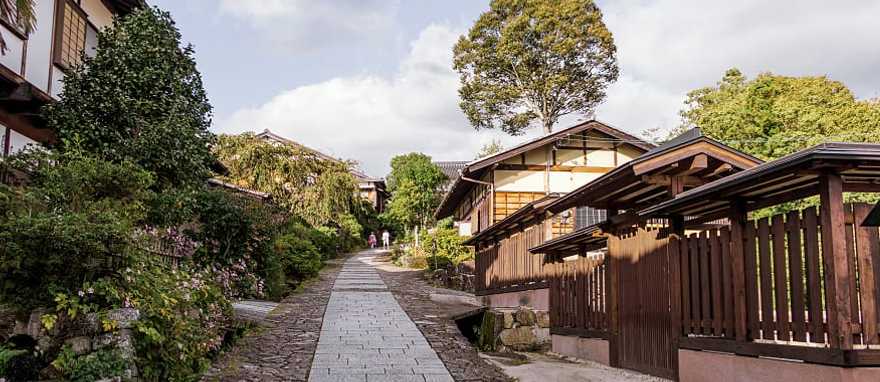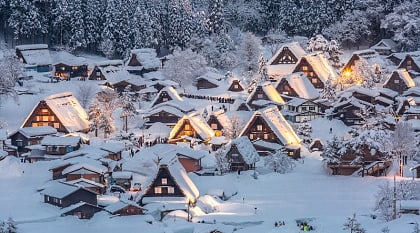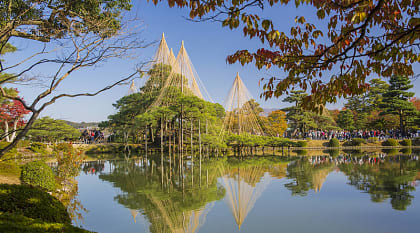Nakasendo Trail Walk: A Classic Japan Tour

What to expect on this itinerary
Complex history and fascinating tradition will emerge during your 14-day historic Japan tour that follows the Nakasendo Trail. Your specialist guides will lead you on private tours to fine snow monkeys in hot springs and traditional accommodations hidden in stunning nature. You will reflect at a Buddhist temple on a secluded summit and delight in delectable seafood while basking in the beauty and wonder of Japan.
Customizable Itinerary
Tokyo – Yokoso to Japan!
Your tour of Japan begins today as your plane touches down at either Narita International Airport. For your time in Tokyo, your luxury hotel is western-style. If you still have energy after your journey, consider exploring Tokyo this evening and enjoying the city’s exciting nightlife.
What's Included:
Tokyo – The City Is Your Oyster
Yudanaka Hot Spring – Friendly Monkeys and Warm Baths
Narai – Life Behind Castle Walls
Tsumago – Small Town Life
Takayama – Delicious Cuisine
Takayama – A City Trapped in Time
Shirakawa-go – Continuing Ancient Traditions
Kanazawa – A Sushi Lover’s Paradise
Mount Koya – Meeting Monks
Kyoto – Home of the Geisha
Kyoto – A Tour Just for You
Kyoto – The Birthplace of Japanese Culture
Kyoto – Sayonara for Now
Trip Highlights
- Traverse segments of the Nakasendo Trail, an enthralling hike filled with stunning nature and captivating history
- Spend a night at the Buddhist temple at Mt. Koya, allowing for a reflective experience
- See the famous Japanese snow monkeys relaxing in the natural outdoor hot springs
- Experience ryokans, traditional Japanese inns that feature tatami mats and onsens, thermal hot springs
- Visit Kanazawa, crowned the Seafood Jewel of the Sea of Japan and indulge in remarkably fresh and delectable seafood cuisines
- Enjoy a day trip to Nara, and delight in local wild deer that will bow for treats
Detailed Description
Not only is Tokyo Japan’s capital, but it is the largest metropolis in the world. Begin your tour in this enthralling capital, where the city is your playground as you travel between secluded parks and skyscrapers. You find yourself wonderfully captivated as you zoom between destinations on the efficient metro system. At night, the streets are illuminated with bright neon. At your fingertips are a variety of delectable Japanese and international cuisine.
You then head to Yudanaka Hot Spring. Located in the heart of central Japan, Yudanaka is home to the famous snow monkey, that, no matter the season, take refuge in the naturally occurring hot springs. This evening, enjoy warm onsen baths at your ryokan, a traditional Japanese inn.
Matsumoto contains one of the most stunning castles in Japan. As you tour the inside, it is easy to imagine yourself transported back to the 18th-century, when samurai roamed these same hallways. The gardens surrounding the castle are another treasure, where in the spring and fall you can find some of Japan’s finest natural beauty.
Narai and Tsumago are two post towns on what was once the Nakasendo Trail. Restored to their full glory, you spend nights in both. During your time there, you have the chance to see what daily life was like hundreds of years ago. Both places are wonderful for picking up a souvenir. You are amazed by how the local artisans continue the world-class craftsmanship that has been handed down through the generations.
For centuries, Takayama was secluded from the rest of Japan. Surrounded by the Japanese Alps, it is a picturesque city. For a day-and-a-half, you explore the old town, which features a variety of sake breweries and workshops. While there, don’t forget to try Hida beef, one of the finest cuts of meat in the world.
Just beyond Takayama is Shirakawa-go, a village where little has changed in the last 300 years. Here, you discover some of the most unique architecture in all of Japan. Touring the village, you gain a deep appreciation for small-town life, and the work performed by residents to keep old traditions alive. You spend the night in Shirakawa-go, and sample locally farmed produce and meat.
You continue on to Kanazawa, a seafood jewel found in the Sea of Japan. Besides some of the finest sushi in the world, the city offers a variety of delights. Spend an afternoon in the contemporary art museum, or relax in the shade of the Kenroukuen Garden, one of the country’s most beautiful. For a unique experience, there is even a ‘Ninja Temple’ that maintains traditions steeped in the past.
Mt. Koya is considered to be one of the holiest places in Japan. Over 100 Buddhist temples line the mountain peaks, demonstrating the great devotion the Japanese have to Buddhism. At Mt. Koya, you are no mere visitor. You are part a grand tradition of pilgrims taking lodging at a Buddhist temple. At the temple, meet the monks and dine on their vegetarian cuisine.
Your final stop is Kyoto, Japan’s ancient capital and home to over 2,000 temples and shrines. During your specially curated guided tour, see the best of what Kyoto has to offer the modern traveler. While there, take a day trip to Nara, home to Todai-ji. There you can examine many splendid artifacts from Japan’s ancient past.
This 14-day tour is perfect for couples, friends, and families. This tour is best taken in spring or fall when Japan’s weather is ideal for outdoor activity.
Starting Price
$9,100 per person (excluding international flights)
Your Zicasso trip is fully customizable, and this sample itinerary is a starting place for your travel plans. Actual costs are dynamic, and your selection of accommodations and activities, your season of travel, and other such variables will bring this budget guideline up or down. Throughout your planning experience with your Zicasso specialist, your itinerary is designed around your budget. You can book your trip when you are satisfied with every detail. Planning your trip with a Zicasso travel specialist is a free service.
What's Included
- Accommodations
- In-country transportation
- Some or all activities and tours
- Expert trip planning
- 24x7 support during your trip
Your final trip cost will vary based on your selected accommodations, activities, meals, and other trip elements that you opt to include.
Verified Traveler Reviews
Based on 716 reviews
Zicasso's travel specialist was very good at interpreting what we were looking for. We were very pleased.
See more
The travel plans were excellent, both for the train arrangements and the hotel accommodations. The three individual guides who escorted us on separate days were wonderful people. We would be delighted to encounter all three of them in the future.
We particularly enjoyed the activities and locations we were escorted to.
We’d definitely do this again with the same guides and the same attention to detail, given our travel and accommodations. Thank you.
See more
Zicasso's was an excellent company. We received quick communication, a detailed itinerary, and they put together a great trip.
See more
We had a lovely time on our trip to Japan. Our guides were pleasant, knowledgeable, and very caring. The drivers were professional and helpful. Zicasso’s travel specialist was also able to assist us at a moment’s notice. We felt we were well cared for throughout our entire trip.
Finally, we felt our itinerary allowed us the opportunity to see as much as possible in the time we had available.
See more
Zicasso’s travel specialist helped us put together a great family trip to Japan. He created the perfect itinerary based on our likes/dislikes and was easy to communicate with. We enjoyed our tour with our guide in Tokyo and were especially delighted that the travel specialist personally guided us around Kyoto. Both he and our guide showed us parts of these cities off the beaten track. The travel specialist is incredibly knowledgeable about Japan and his passion for the culture is contagious.
See more
Zicasso’s travel specialist helped plan an amazing family trip for us. She was always incredibly responsive and everything went perfectly. Hotels were awesome and transportation, tours, and all activities were perfect.
See more





